Analysis of Employment Relations at Workplace in Singapore
VerifiedAdded on 2022/11/17
|7
|2246
|396
Essay
AI Summary
This essay delves into the multifaceted realm of employment relations, examining the development and significance of both formal and informal rules within the workplace, with a specific focus on the context of Singapore. It explores the crucial roles played by various stakeholders, including employers, employees, unions, and government bodies, in shaping these relations. The essay highlights the importance of factors such as pay, working conditions, and employee rights in fostering a positive and productive work environment. It also discusses the impact of company policies, individual and collective agreements, and union rule books in establishing a framework for fair treatment and conflict resolution. Furthermore, the essay analyzes the influence of informal rules, such as shared understandings and cultural norms, on shaping workplace dynamics and employee commitment. It also considers the impact of external factors like the slowing economy and government policies on employment relations in Singapore, suggesting a need for a shift towards a more pluralist approach to address the needs of a diverse workforce. The essay references academic literature and provides insights into the complexities of maintaining healthy employment relations in a dynamic environment.
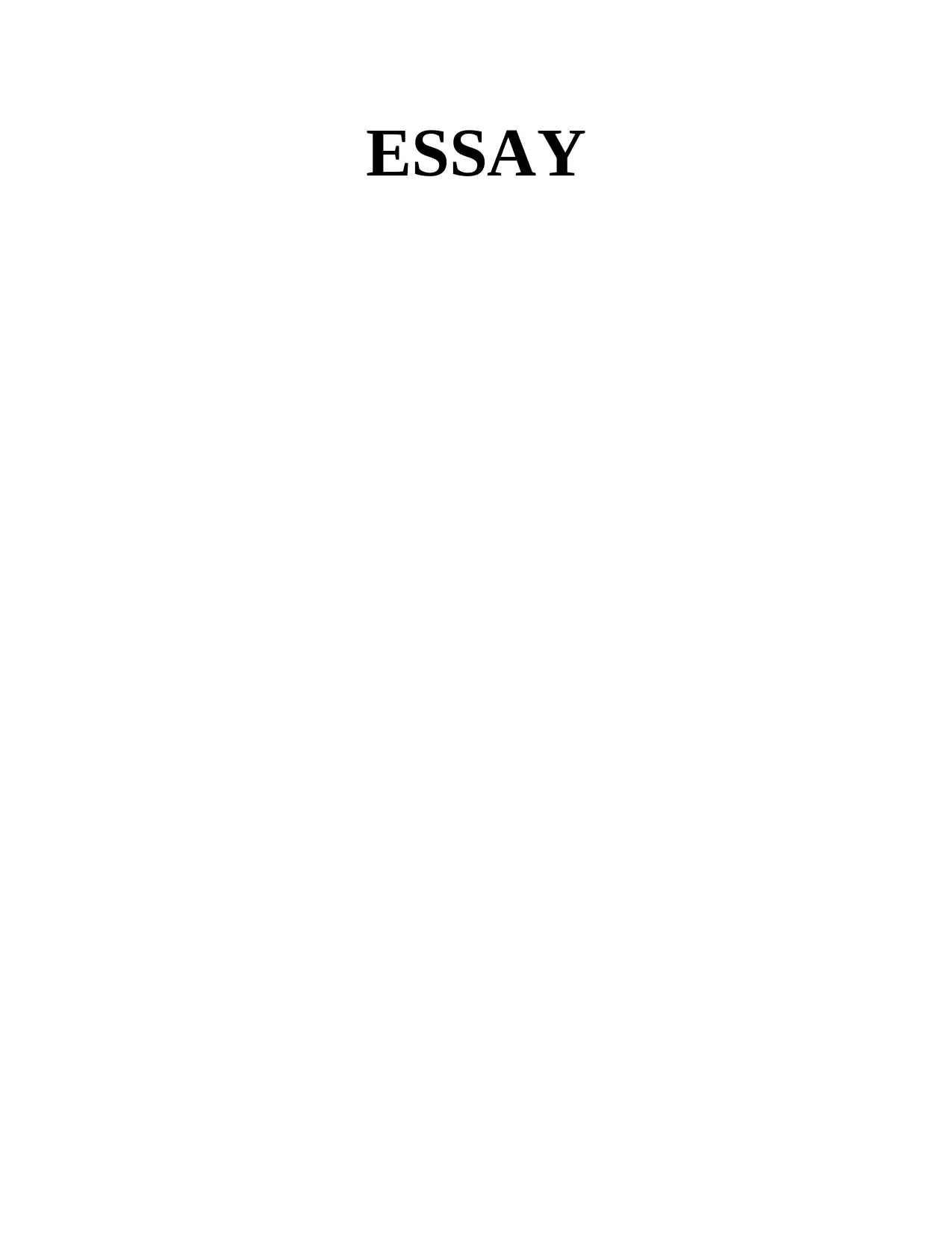
ESSAY
Paraphrase This Document
Need a fresh take? Get an instant paraphrase of this document with our AI Paraphraser
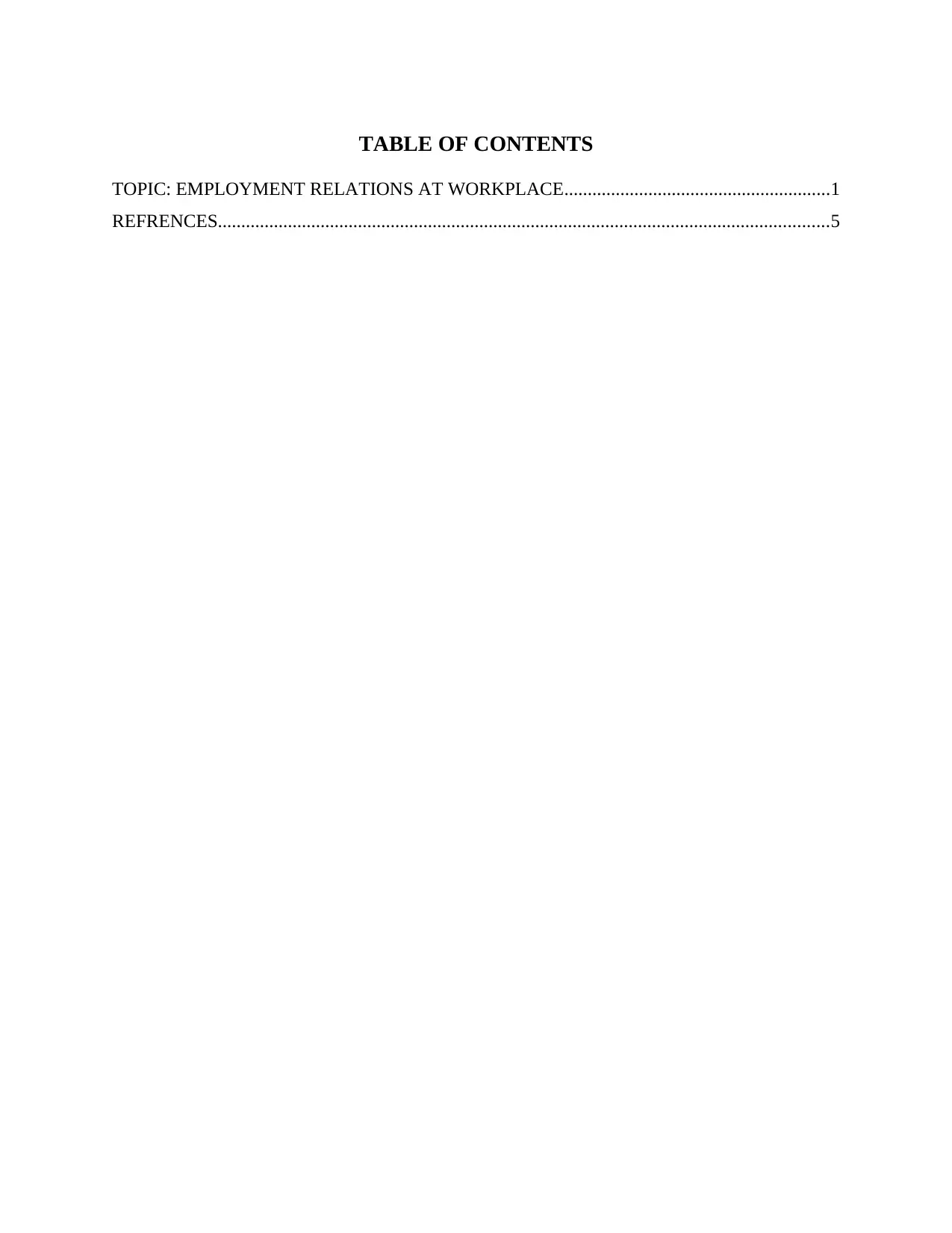
TABLE OF CONTENTS
TOPIC: EMPLOYMENT RELATIONS AT WORKPLACE.........................................................1
REFRENCES...................................................................................................................................5
TOPIC: EMPLOYMENT RELATIONS AT WORKPLACE.........................................................1
REFRENCES...................................................................................................................................5
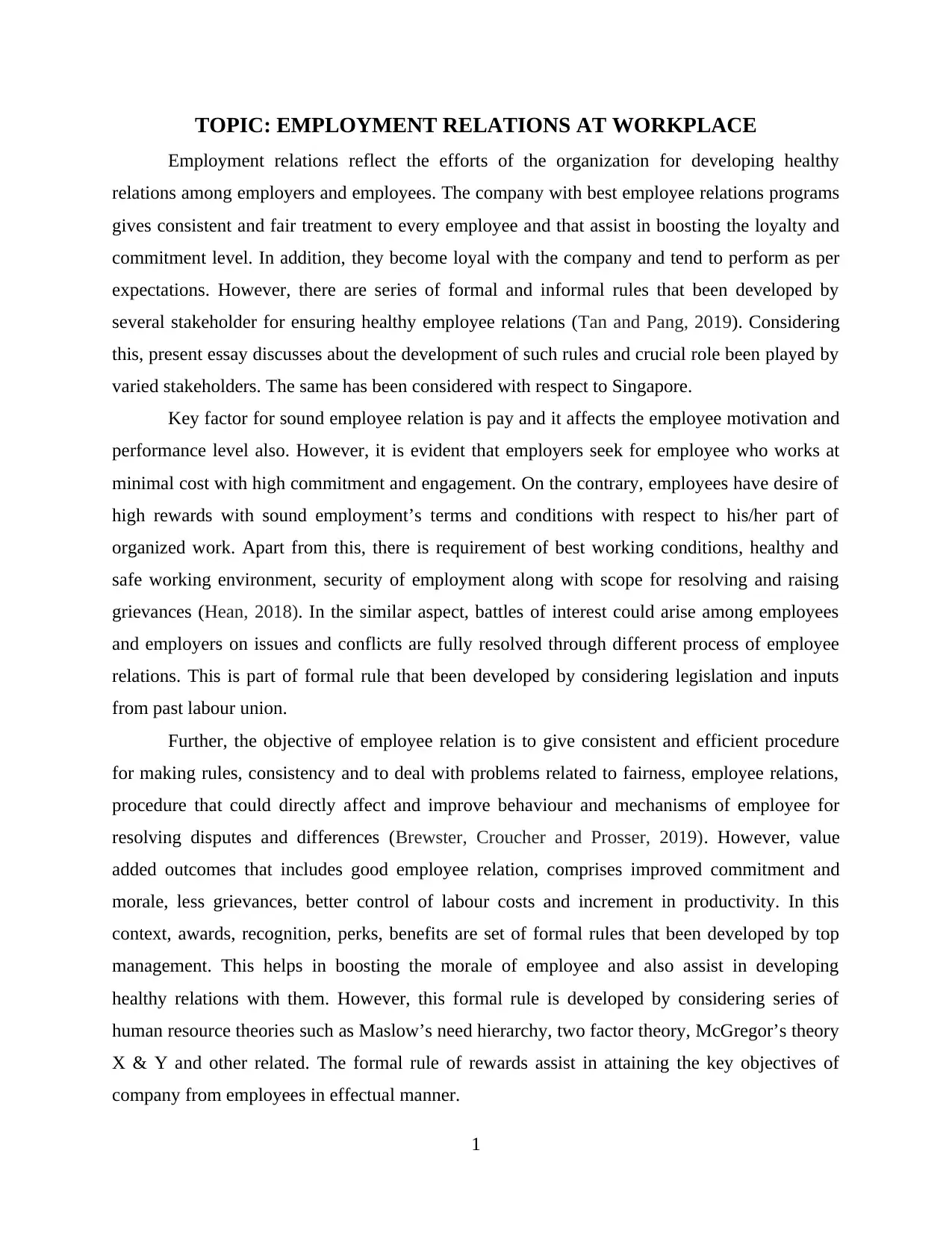
TOPIC: EMPLOYMENT RELATIONS AT WORKPLACE
Employment relations reflect the efforts of the organization for developing healthy
relations among employers and employees. The company with best employee relations programs
gives consistent and fair treatment to every employee and that assist in boosting the loyalty and
commitment level. In addition, they become loyal with the company and tend to perform as per
expectations. However, there are series of formal and informal rules that been developed by
several stakeholder for ensuring healthy employee relations (Tan and Pang, 2019). Considering
this, present essay discusses about the development of such rules and crucial role been played by
varied stakeholders. The same has been considered with respect to Singapore.
Key factor for sound employee relation is pay and it affects the employee motivation and
performance level also. However, it is evident that employers seek for employee who works at
minimal cost with high commitment and engagement. On the contrary, employees have desire of
high rewards with sound employment’s terms and conditions with respect to his/her part of
organized work. Apart from this, there is requirement of best working conditions, healthy and
safe working environment, security of employment along with scope for resolving and raising
grievances (Hean, 2018). In the similar aspect, battles of interest could arise among employees
and employers on issues and conflicts are fully resolved through different process of employee
relations. This is part of formal rule that been developed by considering legislation and inputs
from past labour union.
Further, the objective of employee relation is to give consistent and efficient procedure
for making rules, consistency and to deal with problems related to fairness, employee relations,
procedure that could directly affect and improve behaviour and mechanisms of employee for
resolving disputes and differences (Brewster, Croucher and Prosser, 2019). However, value
added outcomes that includes good employee relation, comprises improved commitment and
morale, less grievances, better control of labour costs and increment in productivity. In this
context, awards, recognition, perks, benefits are set of formal rules that been developed by top
management. This helps in boosting the morale of employee and also assist in developing
healthy relations with them. However, this formal rule is developed by considering series of
human resource theories such as Maslow’s need hierarchy, two factor theory, McGregor’s theory
X & Y and other related. The formal rule of rewards assist in attaining the key objectives of
company from employees in effectual manner.
1
Employment relations reflect the efforts of the organization for developing healthy
relations among employers and employees. The company with best employee relations programs
gives consistent and fair treatment to every employee and that assist in boosting the loyalty and
commitment level. In addition, they become loyal with the company and tend to perform as per
expectations. However, there are series of formal and informal rules that been developed by
several stakeholder for ensuring healthy employee relations (Tan and Pang, 2019). Considering
this, present essay discusses about the development of such rules and crucial role been played by
varied stakeholders. The same has been considered with respect to Singapore.
Key factor for sound employee relation is pay and it affects the employee motivation and
performance level also. However, it is evident that employers seek for employee who works at
minimal cost with high commitment and engagement. On the contrary, employees have desire of
high rewards with sound employment’s terms and conditions with respect to his/her part of
organized work. Apart from this, there is requirement of best working conditions, healthy and
safe working environment, security of employment along with scope for resolving and raising
grievances (Hean, 2018). In the similar aspect, battles of interest could arise among employees
and employers on issues and conflicts are fully resolved through different process of employee
relations. This is part of formal rule that been developed by considering legislation and inputs
from past labour union.
Further, the objective of employee relation is to give consistent and efficient procedure
for making rules, consistency and to deal with problems related to fairness, employee relations,
procedure that could directly affect and improve behaviour and mechanisms of employee for
resolving disputes and differences (Brewster, Croucher and Prosser, 2019). However, value
added outcomes that includes good employee relation, comprises improved commitment and
morale, less grievances, better control of labour costs and increment in productivity. In this
context, awards, recognition, perks, benefits are set of formal rules that been developed by top
management. This helps in boosting the morale of employee and also assist in developing
healthy relations with them. However, this formal rule is developed by considering series of
human resource theories such as Maslow’s need hierarchy, two factor theory, McGregor’s theory
X & Y and other related. The formal rule of rewards assist in attaining the key objectives of
company from employees in effectual manner.
1
⊘ This is a preview!⊘
Do you want full access?
Subscribe today to unlock all pages.

Trusted by 1+ million students worldwide
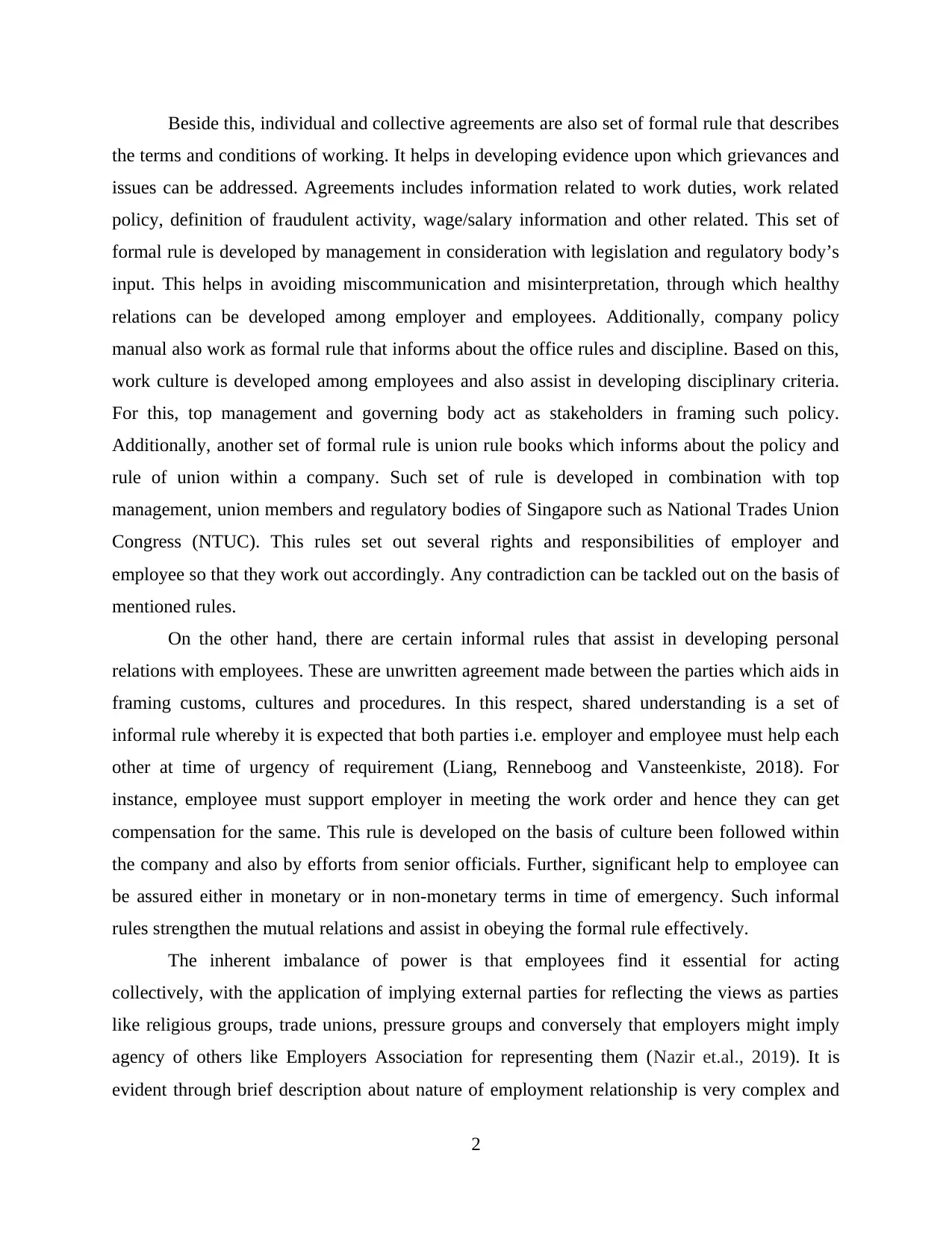
Beside this, individual and collective agreements are also set of formal rule that describes
the terms and conditions of working. It helps in developing evidence upon which grievances and
issues can be addressed. Agreements includes information related to work duties, work related
policy, definition of fraudulent activity, wage/salary information and other related. This set of
formal rule is developed by management in consideration with legislation and regulatory body’s
input. This helps in avoiding miscommunication and misinterpretation, through which healthy
relations can be developed among employer and employees. Additionally, company policy
manual also work as formal rule that informs about the office rules and discipline. Based on this,
work culture is developed among employees and also assist in developing disciplinary criteria.
For this, top management and governing body act as stakeholders in framing such policy.
Additionally, another set of formal rule is union rule books which informs about the policy and
rule of union within a company. Such set of rule is developed in combination with top
management, union members and regulatory bodies of Singapore such as National Trades Union
Congress (NTUC). This rules set out several rights and responsibilities of employer and
employee so that they work out accordingly. Any contradiction can be tackled out on the basis of
mentioned rules.
On the other hand, there are certain informal rules that assist in developing personal
relations with employees. These are unwritten agreement made between the parties which aids in
framing customs, cultures and procedures. In this respect, shared understanding is a set of
informal rule whereby it is expected that both parties i.e. employer and employee must help each
other at time of urgency of requirement (Liang, Renneboog and Vansteenkiste, 2018). For
instance, employee must support employer in meeting the work order and hence they can get
compensation for the same. This rule is developed on the basis of culture been followed within
the company and also by efforts from senior officials. Further, significant help to employee can
be assured either in monetary or in non-monetary terms in time of emergency. Such informal
rules strengthen the mutual relations and assist in obeying the formal rule effectively.
The inherent imbalance of power is that employees find it essential for acting
collectively, with the application of implying external parties for reflecting the views as parties
like religious groups, trade unions, pressure groups and conversely that employers might imply
agency of others like Employers Association for representing them (Nazir et.al., 2019). It is
evident through brief description about nature of employment relationship is very complex and
2
the terms and conditions of working. It helps in developing evidence upon which grievances and
issues can be addressed. Agreements includes information related to work duties, work related
policy, definition of fraudulent activity, wage/salary information and other related. This set of
formal rule is developed by management in consideration with legislation and regulatory body’s
input. This helps in avoiding miscommunication and misinterpretation, through which healthy
relations can be developed among employer and employees. Additionally, company policy
manual also work as formal rule that informs about the office rules and discipline. Based on this,
work culture is developed among employees and also assist in developing disciplinary criteria.
For this, top management and governing body act as stakeholders in framing such policy.
Additionally, another set of formal rule is union rule books which informs about the policy and
rule of union within a company. Such set of rule is developed in combination with top
management, union members and regulatory bodies of Singapore such as National Trades Union
Congress (NTUC). This rules set out several rights and responsibilities of employer and
employee so that they work out accordingly. Any contradiction can be tackled out on the basis of
mentioned rules.
On the other hand, there are certain informal rules that assist in developing personal
relations with employees. These are unwritten agreement made between the parties which aids in
framing customs, cultures and procedures. In this respect, shared understanding is a set of
informal rule whereby it is expected that both parties i.e. employer and employee must help each
other at time of urgency of requirement (Liang, Renneboog and Vansteenkiste, 2018). For
instance, employee must support employer in meeting the work order and hence they can get
compensation for the same. This rule is developed on the basis of culture been followed within
the company and also by efforts from senior officials. Further, significant help to employee can
be assured either in monetary or in non-monetary terms in time of emergency. Such informal
rules strengthen the mutual relations and assist in obeying the formal rule effectively.
The inherent imbalance of power is that employees find it essential for acting
collectively, with the application of implying external parties for reflecting the views as parties
like religious groups, trade unions, pressure groups and conversely that employers might imply
agency of others like Employers Association for representing them (Nazir et.al., 2019). It is
evident through brief description about nature of employment relationship is very complex and
2
Paraphrase This Document
Need a fresh take? Get an instant paraphrase of this document with our AI Paraphraser
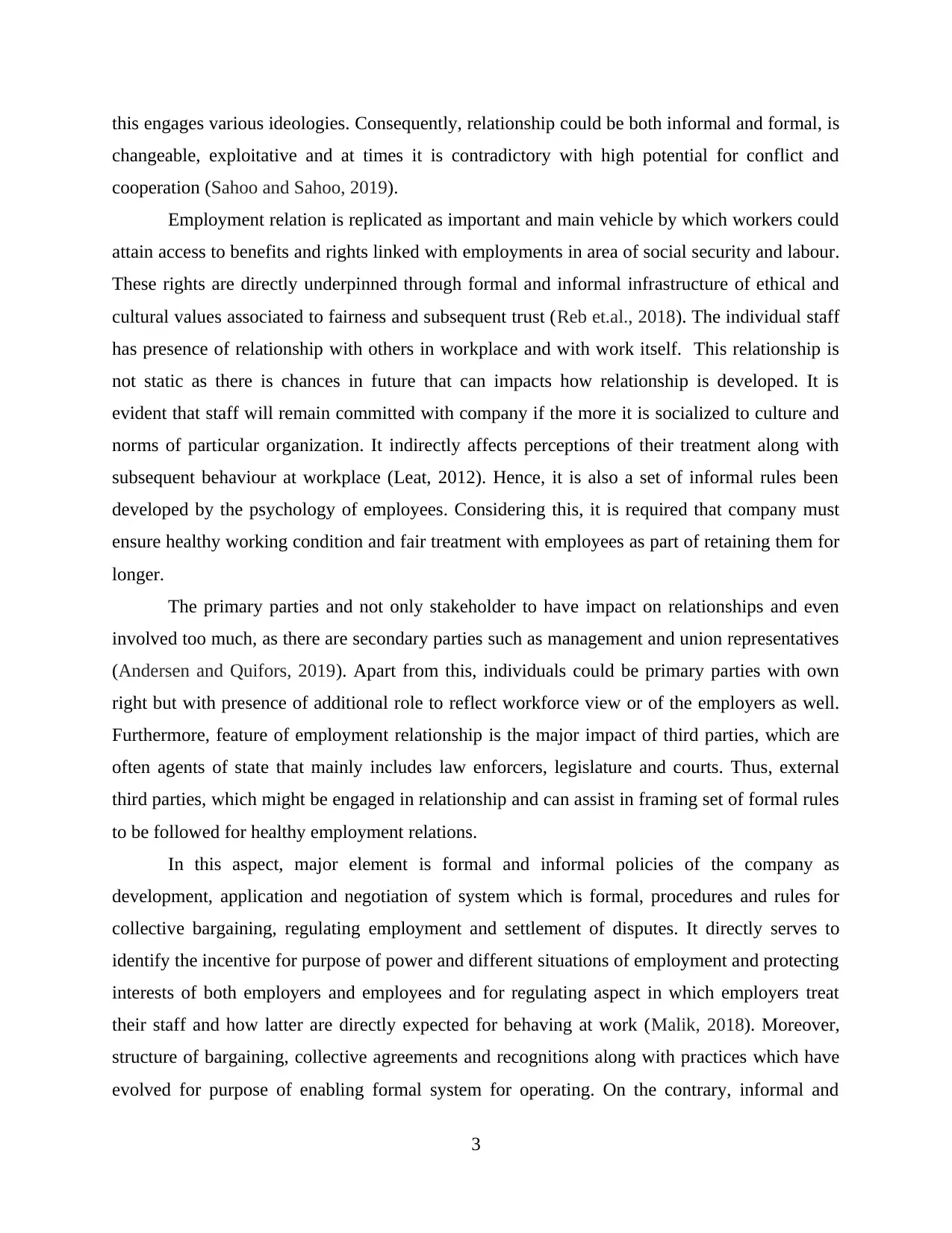
this engages various ideologies. Consequently, relationship could be both informal and formal, is
changeable, exploitative and at times it is contradictory with high potential for conflict and
cooperation (Sahoo and Sahoo, 2019).
Employment relation is replicated as important and main vehicle by which workers could
attain access to benefits and rights linked with employments in area of social security and labour.
These rights are directly underpinned through formal and informal infrastructure of ethical and
cultural values associated to fairness and subsequent trust (Reb et.al., 2018). The individual staff
has presence of relationship with others in workplace and with work itself. This relationship is
not static as there is chances in future that can impacts how relationship is developed. It is
evident that staff will remain committed with company if the more it is socialized to culture and
norms of particular organization. It indirectly affects perceptions of their treatment along with
subsequent behaviour at workplace (Leat, 2012). Hence, it is also a set of informal rules been
developed by the psychology of employees. Considering this, it is required that company must
ensure healthy working condition and fair treatment with employees as part of retaining them for
longer.
The primary parties and not only stakeholder to have impact on relationships and even
involved too much, as there are secondary parties such as management and union representatives
(Andersen and Quifors, 2019). Apart from this, individuals could be primary parties with own
right but with presence of additional role to reflect workforce view or of the employers as well.
Furthermore, feature of employment relationship is the major impact of third parties, which are
often agents of state that mainly includes law enforcers, legislature and courts. Thus, external
third parties, which might be engaged in relationship and can assist in framing set of formal rules
to be followed for healthy employment relations.
In this aspect, major element is formal and informal policies of the company as
development, application and negotiation of system which is formal, procedures and rules for
collective bargaining, regulating employment and settlement of disputes. It directly serves to
identify the incentive for purpose of power and different situations of employment and protecting
interests of both employers and employees and for regulating aspect in which employers treat
their staff and how latter are directly expected for behaving at work (Malik, 2018). Moreover,
structure of bargaining, collective agreements and recognitions along with practices which have
evolved for purpose of enabling formal system for operating. On the contrary, informal and
3
changeable, exploitative and at times it is contradictory with high potential for conflict and
cooperation (Sahoo and Sahoo, 2019).
Employment relation is replicated as important and main vehicle by which workers could
attain access to benefits and rights linked with employments in area of social security and labour.
These rights are directly underpinned through formal and informal infrastructure of ethical and
cultural values associated to fairness and subsequent trust (Reb et.al., 2018). The individual staff
has presence of relationship with others in workplace and with work itself. This relationship is
not static as there is chances in future that can impacts how relationship is developed. It is
evident that staff will remain committed with company if the more it is socialized to culture and
norms of particular organization. It indirectly affects perceptions of their treatment along with
subsequent behaviour at workplace (Leat, 2012). Hence, it is also a set of informal rules been
developed by the psychology of employees. Considering this, it is required that company must
ensure healthy working condition and fair treatment with employees as part of retaining them for
longer.
The primary parties and not only stakeholder to have impact on relationships and even
involved too much, as there are secondary parties such as management and union representatives
(Andersen and Quifors, 2019). Apart from this, individuals could be primary parties with own
right but with presence of additional role to reflect workforce view or of the employers as well.
Furthermore, feature of employment relationship is the major impact of third parties, which are
often agents of state that mainly includes law enforcers, legislature and courts. Thus, external
third parties, which might be engaged in relationship and can assist in framing set of formal rules
to be followed for healthy employment relations.
In this aspect, major element is formal and informal policies of the company as
development, application and negotiation of system which is formal, procedures and rules for
collective bargaining, regulating employment and settlement of disputes. It directly serves to
identify the incentive for purpose of power and different situations of employment and protecting
interests of both employers and employees and for regulating aspect in which employers treat
their staff and how latter are directly expected for behaving at work (Malik, 2018). Moreover,
structure of bargaining, collective agreements and recognitions along with practices which have
evolved for purpose of enabling formal system for operating. On the contrary, informal and
3
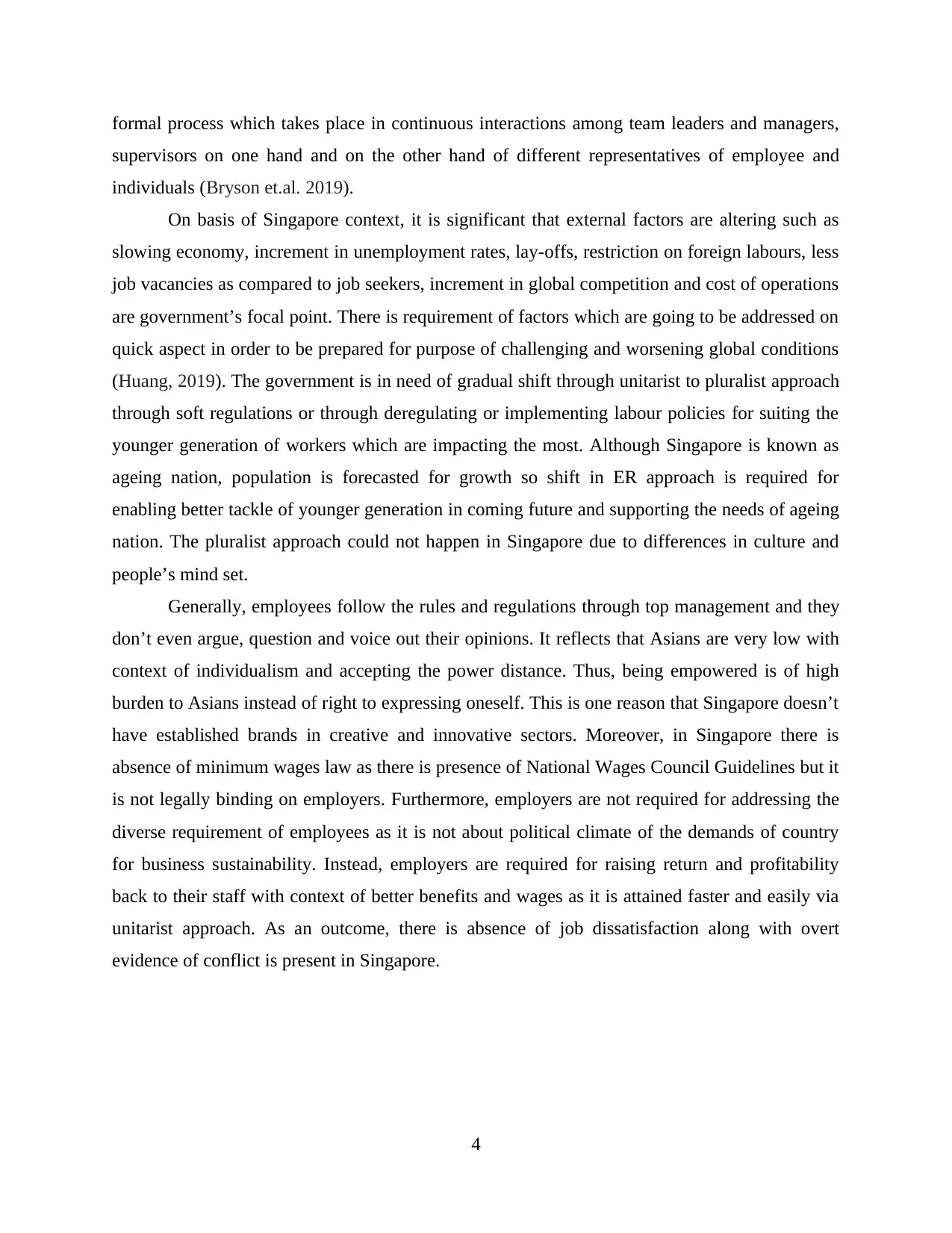
formal process which takes place in continuous interactions among team leaders and managers,
supervisors on one hand and on the other hand of different representatives of employee and
individuals (Bryson et.al. 2019).
On basis of Singapore context, it is significant that external factors are altering such as
slowing economy, increment in unemployment rates, lay-offs, restriction on foreign labours, less
job vacancies as compared to job seekers, increment in global competition and cost of operations
are government’s focal point. There is requirement of factors which are going to be addressed on
quick aspect in order to be prepared for purpose of challenging and worsening global conditions
(Huang, 2019). The government is in need of gradual shift through unitarist to pluralist approach
through soft regulations or through deregulating or implementing labour policies for suiting the
younger generation of workers which are impacting the most. Although Singapore is known as
ageing nation, population is forecasted for growth so shift in ER approach is required for
enabling better tackle of younger generation in coming future and supporting the needs of ageing
nation. The pluralist approach could not happen in Singapore due to differences in culture and
people’s mind set.
Generally, employees follow the rules and regulations through top management and they
don’t even argue, question and voice out their opinions. It reflects that Asians are very low with
context of individualism and accepting the power distance. Thus, being empowered is of high
burden to Asians instead of right to expressing oneself. This is one reason that Singapore doesn’t
have established brands in creative and innovative sectors. Moreover, in Singapore there is
absence of minimum wages law as there is presence of National Wages Council Guidelines but it
is not legally binding on employers. Furthermore, employers are not required for addressing the
diverse requirement of employees as it is not about political climate of the demands of country
for business sustainability. Instead, employers are required for raising return and profitability
back to their staff with context of better benefits and wages as it is attained faster and easily via
unitarist approach. As an outcome, there is absence of job dissatisfaction along with overt
evidence of conflict is present in Singapore.
4
supervisors on one hand and on the other hand of different representatives of employee and
individuals (Bryson et.al. 2019).
On basis of Singapore context, it is significant that external factors are altering such as
slowing economy, increment in unemployment rates, lay-offs, restriction on foreign labours, less
job vacancies as compared to job seekers, increment in global competition and cost of operations
are government’s focal point. There is requirement of factors which are going to be addressed on
quick aspect in order to be prepared for purpose of challenging and worsening global conditions
(Huang, 2019). The government is in need of gradual shift through unitarist to pluralist approach
through soft regulations or through deregulating or implementing labour policies for suiting the
younger generation of workers which are impacting the most. Although Singapore is known as
ageing nation, population is forecasted for growth so shift in ER approach is required for
enabling better tackle of younger generation in coming future and supporting the needs of ageing
nation. The pluralist approach could not happen in Singapore due to differences in culture and
people’s mind set.
Generally, employees follow the rules and regulations through top management and they
don’t even argue, question and voice out their opinions. It reflects that Asians are very low with
context of individualism and accepting the power distance. Thus, being empowered is of high
burden to Asians instead of right to expressing oneself. This is one reason that Singapore doesn’t
have established brands in creative and innovative sectors. Moreover, in Singapore there is
absence of minimum wages law as there is presence of National Wages Council Guidelines but it
is not legally binding on employers. Furthermore, employers are not required for addressing the
diverse requirement of employees as it is not about political climate of the demands of country
for business sustainability. Instead, employers are required for raising return and profitability
back to their staff with context of better benefits and wages as it is attained faster and easily via
unitarist approach. As an outcome, there is absence of job dissatisfaction along with overt
evidence of conflict is present in Singapore.
4
⊘ This is a preview!⊘
Do you want full access?
Subscribe today to unlock all pages.

Trusted by 1+ million students worldwide
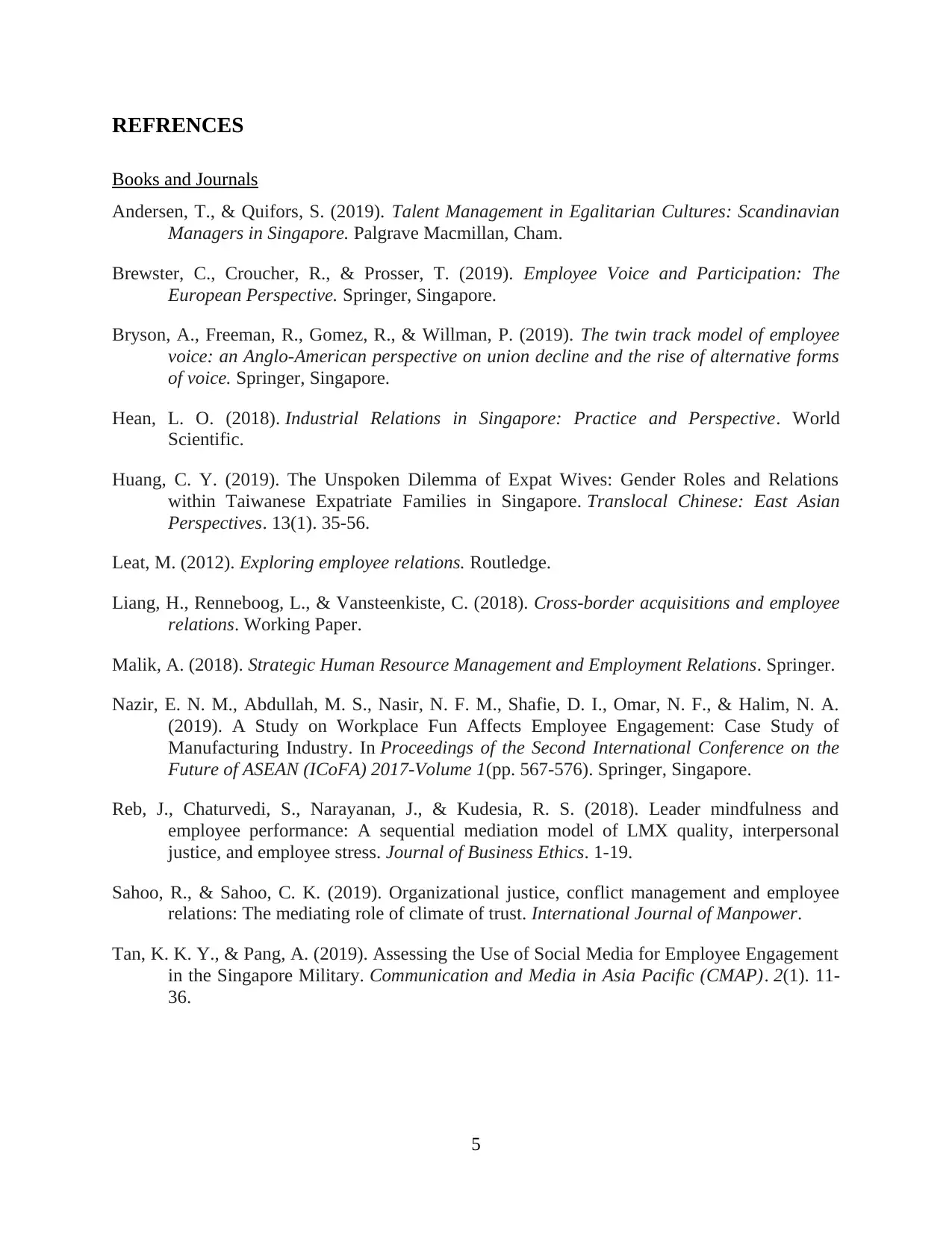
REFRENCES
Books and Journals
Andersen, T., & Quifors, S. (2019). Talent Management in Egalitarian Cultures: Scandinavian
Managers in Singapore. Palgrave Macmillan, Cham.
Brewster, C., Croucher, R., & Prosser, T. (2019). Employee Voice and Participation: The
European Perspective. Springer, Singapore.
Bryson, A., Freeman, R., Gomez, R., & Willman, P. (2019). The twin track model of employee
voice: an Anglo-American perspective on union decline and the rise of alternative forms
of voice. Springer, Singapore.
Hean, L. O. (2018). Industrial Relations in Singapore: Practice and Perspective. World
Scientific.
Huang, C. Y. (2019). The Unspoken Dilemma of Expat Wives: Gender Roles and Relations
within Taiwanese Expatriate Families in Singapore. Translocal Chinese: East Asian
Perspectives. 13(1). 35-56.
Leat, M. (2012). Exploring employee relations. Routledge.
Liang, H., Renneboog, L., & Vansteenkiste, C. (2018). Cross-border acquisitions and employee
relations. Working Paper.
Malik, A. (2018). Strategic Human Resource Management and Employment Relations. Springer.
Nazir, E. N. M., Abdullah, M. S., Nasir, N. F. M., Shafie, D. I., Omar, N. F., & Halim, N. A.
(2019). A Study on Workplace Fun Affects Employee Engagement: Case Study of
Manufacturing Industry. In Proceedings of the Second International Conference on the
Future of ASEAN (ICoFA) 2017-Volume 1(pp. 567-576). Springer, Singapore.
Reb, J., Chaturvedi, S., Narayanan, J., & Kudesia, R. S. (2018). Leader mindfulness and
employee performance: A sequential mediation model of LMX quality, interpersonal
justice, and employee stress. Journal of Business Ethics. 1-19.
Sahoo, R., & Sahoo, C. K. (2019). Organizational justice, conflict management and employee
relations: The mediating role of climate of trust. International Journal of Manpower.
Tan, K. K. Y., & Pang, A. (2019). Assessing the Use of Social Media for Employee Engagement
in the Singapore Military. Communication and Media in Asia Pacific (CMAP). 2(1). 11-
36.
5
Books and Journals
Andersen, T., & Quifors, S. (2019). Talent Management in Egalitarian Cultures: Scandinavian
Managers in Singapore. Palgrave Macmillan, Cham.
Brewster, C., Croucher, R., & Prosser, T. (2019). Employee Voice and Participation: The
European Perspective. Springer, Singapore.
Bryson, A., Freeman, R., Gomez, R., & Willman, P. (2019). The twin track model of employee
voice: an Anglo-American perspective on union decline and the rise of alternative forms
of voice. Springer, Singapore.
Hean, L. O. (2018). Industrial Relations in Singapore: Practice and Perspective. World
Scientific.
Huang, C. Y. (2019). The Unspoken Dilemma of Expat Wives: Gender Roles and Relations
within Taiwanese Expatriate Families in Singapore. Translocal Chinese: East Asian
Perspectives. 13(1). 35-56.
Leat, M. (2012). Exploring employee relations. Routledge.
Liang, H., Renneboog, L., & Vansteenkiste, C. (2018). Cross-border acquisitions and employee
relations. Working Paper.
Malik, A. (2018). Strategic Human Resource Management and Employment Relations. Springer.
Nazir, E. N. M., Abdullah, M. S., Nasir, N. F. M., Shafie, D. I., Omar, N. F., & Halim, N. A.
(2019). A Study on Workplace Fun Affects Employee Engagement: Case Study of
Manufacturing Industry. In Proceedings of the Second International Conference on the
Future of ASEAN (ICoFA) 2017-Volume 1(pp. 567-576). Springer, Singapore.
Reb, J., Chaturvedi, S., Narayanan, J., & Kudesia, R. S. (2018). Leader mindfulness and
employee performance: A sequential mediation model of LMX quality, interpersonal
justice, and employee stress. Journal of Business Ethics. 1-19.
Sahoo, R., & Sahoo, C. K. (2019). Organizational justice, conflict management and employee
relations: The mediating role of climate of trust. International Journal of Manpower.
Tan, K. K. Y., & Pang, A. (2019). Assessing the Use of Social Media for Employee Engagement
in the Singapore Military. Communication and Media in Asia Pacific (CMAP). 2(1). 11-
36.
5
1 out of 7
Related Documents
Your All-in-One AI-Powered Toolkit for Academic Success.
+13062052269
info@desklib.com
Available 24*7 on WhatsApp / Email
![[object Object]](/_next/static/media/star-bottom.7253800d.svg)
Unlock your academic potential
Copyright © 2020–2025 A2Z Services. All Rights Reserved. Developed and managed by ZUCOL.





